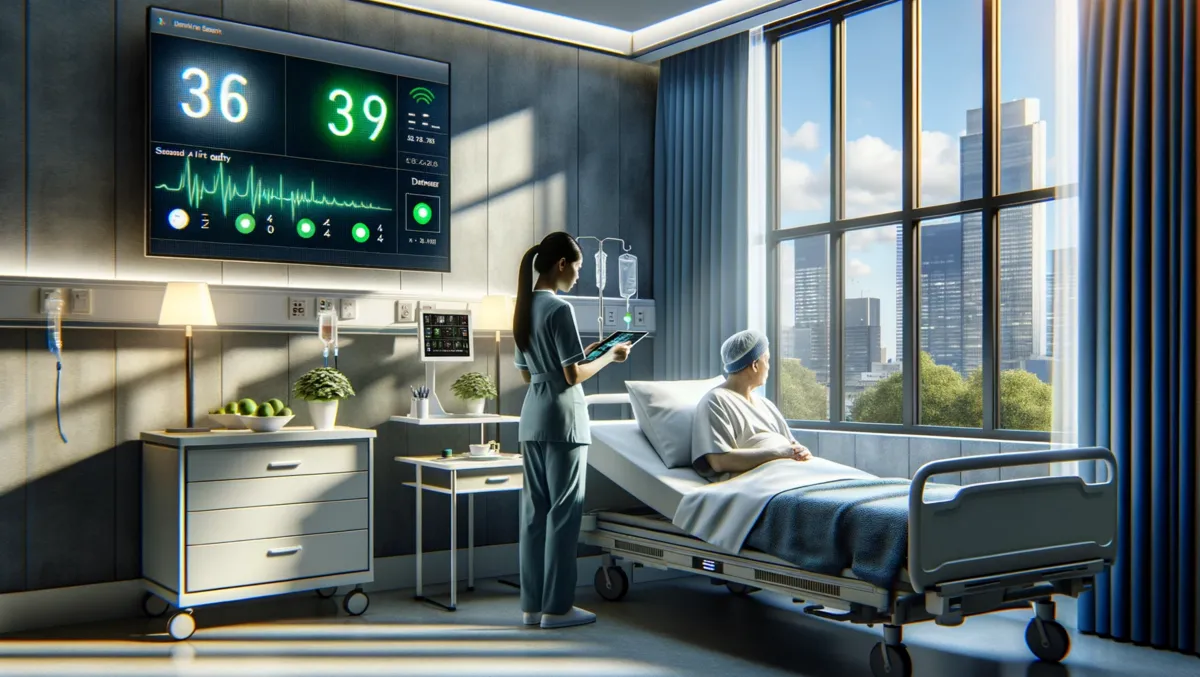
How improved air quality aids patient recovery and satisfaction
Maintaining high Indoor Air Quality (IAQ) and detecting poor IAQ are top concerns for hospitals in delivering patient-centric care. Scientific studies show that cleaner air reduces the risk of hospital-acquired infections, improving patient recovery rates. High IQA benefits patients with a comfortable environment and staff with fewer sick days and higher productivity.
Using air quality sensors and data-driven video technology (AI combined with video), hospitals can proactively monitor air quality and identify risks. Addressing these issues enhances patient safety and improves health outcomes.
The Power of Sensor-Video Combination in Hospitals
Air quality sensors play a crucial role by detecting changes in air quality and providing analytical data about the concentration of pollutants. They decipher the 'what' - the presence and levels of pollutants such as particulate matter or volatile organic compounds (VOCs) that can lead to respiratory problems or infections.
However, these sensors alone cannot always provide insights into the 'why' - the root causes behind changes in air quality. This is where video comes into play. By integrating data-driven video technology with air quality sensors, hospitals can observe and investigate the sources of air quality issues. Video feeds provide the visual context necessary to interpret the data, whether it's construction work stirring up dust, a malfunctioning HVAC system contributing to poor air quality, or a sudden influx of cars causing an increase in exhaust fumes.
This dual approach provides a comprehensive solution for managing air quality in hospitals. Sensors offer hard data, providing undeniable proof of issues, while video enhances understanding of the underlying reasons. This enables informed decision-making to promptly address air quality concerns, ensuring a healthy environment for patients and staff. By combining air quality sensors with video technology, hospitals can take a proactive approach to air quality management.
Hospitals are Unique Environments
Managing air quality is crucial for hospitals as it directly affects the health of patients, visitors, and healthcare workers. Hospitals are unique environments requiring high indoor air quality standards for better patient outcomes. Maintaining optimal air quality within hospitals is essential for many critical reasons:
Infection control: Poor indoor air quality in hospitals can lead to the spread of airborne illnesses like COVID-19, tuberculosis, and the flu, especially for immunocompromised patients.
Respiratory health: Indoor air pollutants such as dust, mould, and chemicals can trigger respiratory issues in patients with asthma or other conditions.
Comfort and well-being: Hospitals are stressful environments, and inadequate indoor air quality can worsen discomfort, anxiety, and stress in patients and staff.
Tools to Manage Air Quality proactively
Data-driven video technology can be an essential tool for hospitals looking to leverage integrated analytics to monitor air quality (as well as many other environmental factors) and manage a wide range of smart edge devices and sensors. Using sensors and video together provides real-time data that can accurately monitor air quality and detect possible health hazards.
This sensor-video combination enables hospital staff to take a proactive approach with the potential to mitigate air quality-related issues and make the environment healthier and more pleasant for patients and staff alike. Top air quality concerns within a hospital or healthcare facility can include the following:
Airborne Pathogens: Hospitals, with their crowded environment of patients, visitors, and staff, pose a higher risk of airborne pathogens like bacteria, viruses, and fungi that can infect vulnerable patients.
Volatile Organic Compounds (VOCs): Hospitals use various chemicals for cleaning and disinfection, which can release VOCs into the air. Exposure to high levels of VOCs can cause eye, nose, and throat irritation, headaches, nausea, and even cancer.
Particulate Matter (PM): Particulate matter consists of tiny inhalable particles that can lead to respiratory problems. Hospitals can generate PM during cleaning, construction, and medical procedures. Proper filtration and ventilation are necessary to control PM concentration.
Temperature and Humidity: Hospitals must maintain specific temperature and humidity conditions for patient and staff comfort and safety. High temperatures and humidity can promote mould growth and other pathogens, while low humidity can cause respiratory dryness and irritation.
Odours: Hospitals can produce unpleasant odours from food and medical waste. Effective ventilation and odour control measures are crucial for maintaining a comfortable and healthy environment.
Proactively managing IAQ is crucial for hospitals to comply with healthcare standards, such as the American Society for Healthcare Engineering (ASHE) Standard 170. It not only improves daily operations but also enhances the patient experience and satisfaction. By prioritizing IAQ, hospitals can create a healthier environment while meeting regulations and improving overall satisfaction.
Video management software at the core
At the core of a combined sensor-video solution lies the video management software (VMS). To empower hospitals in proactively managing air quality, the VMS needs to be built on an open platform that seamlessly integrates various types of sensors and video cameras from different manufacturers. The VMS efficiently captures and stores real-time data from diverse sources, such as IoT devices and APIs, consolidating it in a central repository for easy access and analysis.
The VMS allows staff to visually verify alarm events, like checking for people in areas with air quality concerns. It can also use machine learning to identify patterns and anomalies, providing insights into air quality trends and pollution sources. These insights are presented through intuitive visualizations, including dashboards, maps, and charts, making it easy to understand the data.
By combining air quality sensors with data-driven video technology, hospital staff can gain insights into both the cause and effect. This approach enables informed decision-making and proactive measures to improve air quality throughout the hospital. Whether patients, visitors, or staff, everyone can enjoy a breath of fresh air wherever they are in the hospital.

